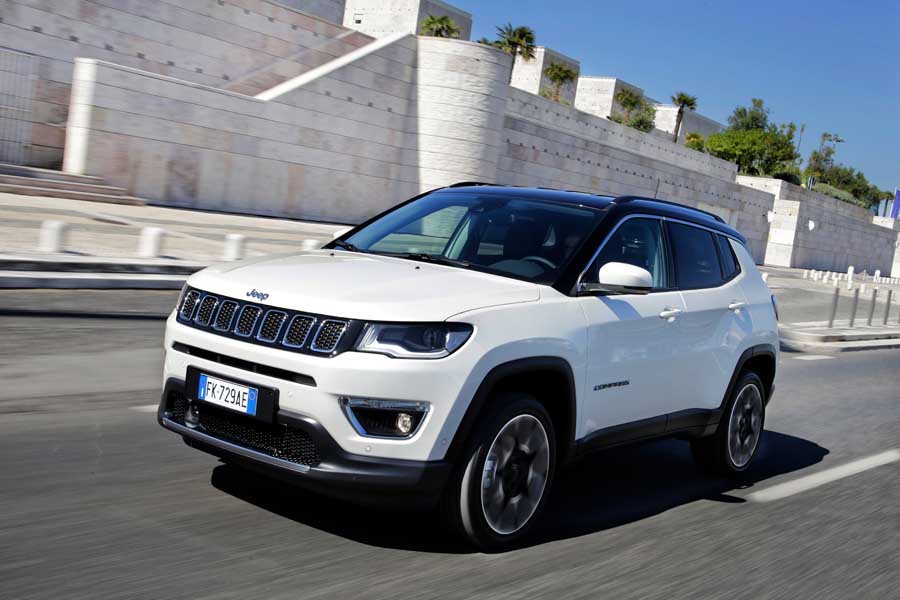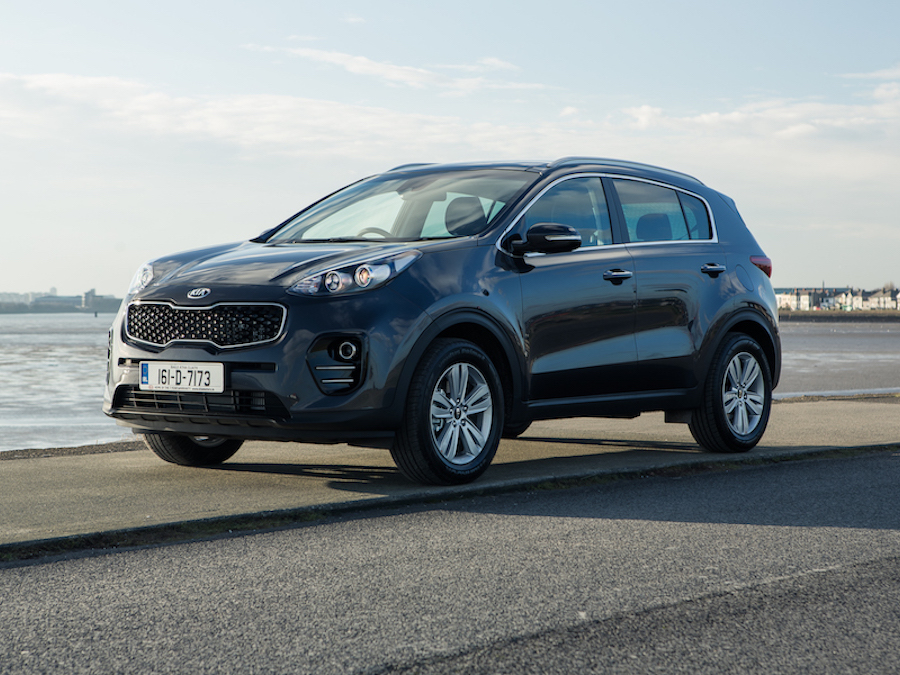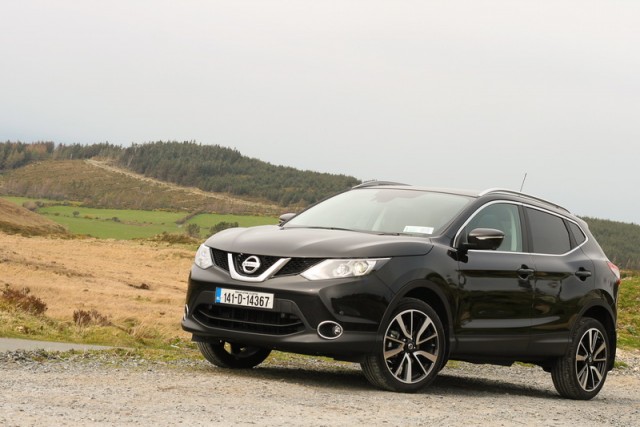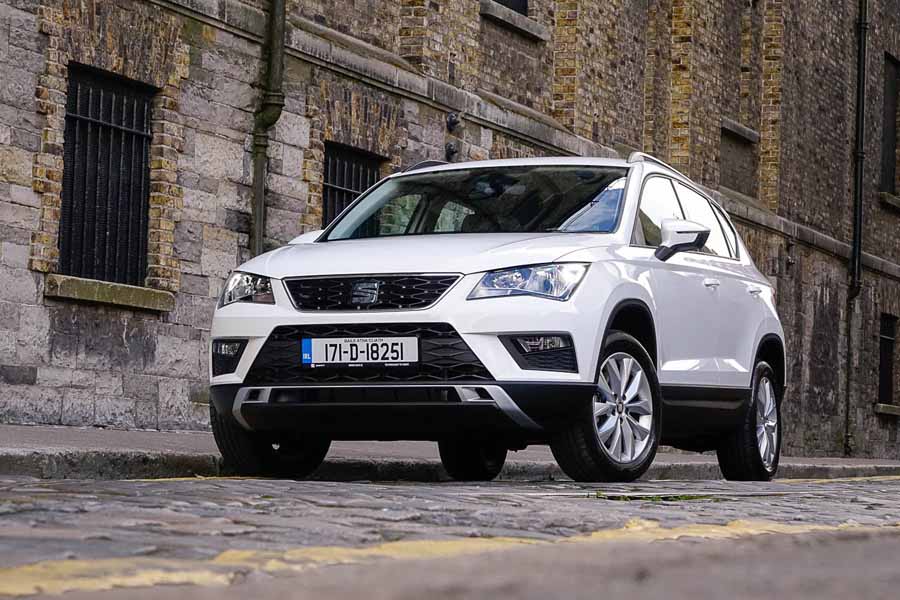There hasn't been a Jeep Compass on sale since 2014, and in those intervening years the burgeoning crossover segment has become even more competitive. Now Jeep is back in the sector and this new Compass looks every bit how a new Jeep in this segment should, but design alone won't cut it in this fiercely cut-throat part of the market.
In the metal
We're big fans of the smaller Jeep Renegade's youthful and Tonka truck styling, but in the new Compass, Jeep is gunning for mass appeal. It looks very much like a downsized Grand Cherokee, with a few more curves along the sides and around the rear. There is, of course, that signature seven-slot front grille, which sits in a gloss black panel linking the headlights. Look a little closer and you'll notice that the mesh-like plastic grille is blanked off inside, which may annoy the purists. Nonetheless, Jeep's designers have incorporated a lot of detail within the headlight units, including a white section that is said to resemble the white of an eye.
As with an increasing number of crossovers, there is the choice of a contrasting black roof that gives the impression it slopes down further towards the rear than it does in reality. Meanwhile, the chrome window trim on this higher 'Limited' trim grade wraps the whole way around the car and is reflected by the design in the LED rear lights. It's not all curves though; the trapezoidal wheel arches (a Jeep signature) remain, although even optional 19-inch alloy wheels struggle to fill them, especially at the back.
Inside, the cabin is a more conventional affair except for a sculpted dashboard top that mimics the bonnet's design. The look and feel of the materials used throughout the cabin are good, a little better than what you would typically find in a Nissan Qashqai or Renault Kadjar. The steering wheel is chunky and the multifunction controls sit flush. Jeep has kept the instrument cluster a simple affair too, with two easy-to-read dials for the tachometer and speedometer, and in-between is either a 3.5- or 7-inch LED display, depending on specification.
The centre console is clearly divided, with the top section playing host to Jeep's UConnect touchscreen. Entry-level Compass models will get a five-inch unit, while the majority models will feature a seven-inch screen. Buyers will have the choice of an optional 8.4-inch screen too, featuring Android Auto and Apple CarPlay.
While the Compass has good headroom, even with the optional panoramic sunroof, the cabin doesn't feel exceptionally wide, with only a small space between the front seats. The door storage bins aren't that big either, and the rest of the cabin is light on storage areas compared to some rivals. The boot is also on the small side considering the Compass' overall size; the volume is 438 litres providing you choose not to have a spare wheel; otherwise, this shrinks to 388 litres. It does come with a moveable floor, and folding the rear seats brings capacity up to 1,251 litres.
Driving it
Jeep may be renowned for its off-road abilities, but even in the crossover market many buyers rarely venture any closer to nature than the local park. With that in mind, this front-wheel-drive Compass is sure to be the more popular choice with buyers in Ireland, helped further by its lower CO2 emissions that should see it classed in Band A4 with an annual cost of €200.
Its engine line-up comes from within the Fiat Chrysler Automobiles Group and this 120hp 1.6-litre MultiJet II diesel is the most economical of the engines offered. According to official figures it consumes 4.4 litres/100km, but the turbocharged four-cylinder and its transmission feel tuned more for economy than pace and around town especially you find yourself changing gears more frequently than is ideal.
Even on more open stretches, any incline, for example, can soon have you considering a quick downshift if the revs fall away from the narrow power band. On the upside, despite having to work the gears a bit more, the four-cylinder engine doesn't feel as coarse as some other 1.6-litre diesel motors. Even at higher cruising speeds, the noise levels in the cabin are low, helped in part by a long sixth gear that keeps engine speeds down.
At speed comfort is good, but the nature of the suspension's setup means that on some smaller, uneven roads the ride quality is less impressive. It can feel overly busy at times and lacks the refined damping that an increasing number of rivals have. One of the factors in this is that the front-wheel-drive models have the lowest ride height in the Compass range. A quick test of the more off-road biased Compass Trailhawk model, which gains 3.6cm in height, revealed a smoother ride on a variety of surfaces.
Jeep, like most, has employed an electrically assisted power steering setup for the Compass. To its credit, it feels light and manoeuvrable around city streets, but the steering lacks any real sense of precision or even increased weighting up in corners. While we can forgive the Compass for not handling like a sports car, the lack of refinement, given its aim to be positioned in the more premium side of the segment, leaves plenty to be desired.
What you get for your money
The Jeep Compass comes in three specification grades, but Jeep only offers the entry-level 'Sport' with the 1.6-litre diesel and front-wheel drive. At that level, the standard equipment includes 16-inch alloy wheels, LED tail lights and automatic headlights. Inside, there's a leather multifunction steering wheel, black cloth upholstery, electric front windows and ambient lighting. A good mix of safety features is also included, such as six airbags, lane departure warning, forward collision warning, trailer sway control and hill hold assist.
Mid-level Longitude specification is available with the 1.4-litre petrol engine or 1.6- and 2.0-litre diesels, all with manual transmissions, though the larger diesel engine gets all-wheel drive as standard. The Longitude grade adds 17-inch alloy wheels, front fog lamps with a cornering function, rear parking sensors and reversing camera. Keyless entry and an 8.4-inch Uconnect touchscreen infotainment with Android Auto and Apple CarPlay add a further level of convenience to the Compass.
The top-level Limited specification can be had with all powertrains, including an automatic transmission for the 2.0-litre diesel. Visually, the car gains 18-inch alloy wheels, projector headlights with LED daytime running lights, chrome roof rails, front bumper inserts, fog light surrounds and rear exhaust tips and rear privacy glass. Equipment includes front and rear parking sensors, blind spot monitoring, rear cross path detection, parallel and perpendicular park assist, a heated leather multifunction steering wheel, heated front seats that are electrically adjustable, leather upholstery and a seven-inch TFT display in the instrument cluster, while the 8.4-inch infotainment display is joined by a 560-watt BeatsAudio sound system.
Summary
At first glance, the Jeep Compass appears to tick all the right boxes for the crossover segment, but it's when you get a little closer you begin to see where it falls short. With less boot space than many of its rivals and an interior that is at best average, we can't help but feel that the Compass could have been better than it is. The ride quality is another area that still leaves room for improvement, and while the 1.6-litre engine appears to be fuel efficient, it doesn't have the same drivability as its European competitors. There's work still to be done here to grab buyers' attention.




















